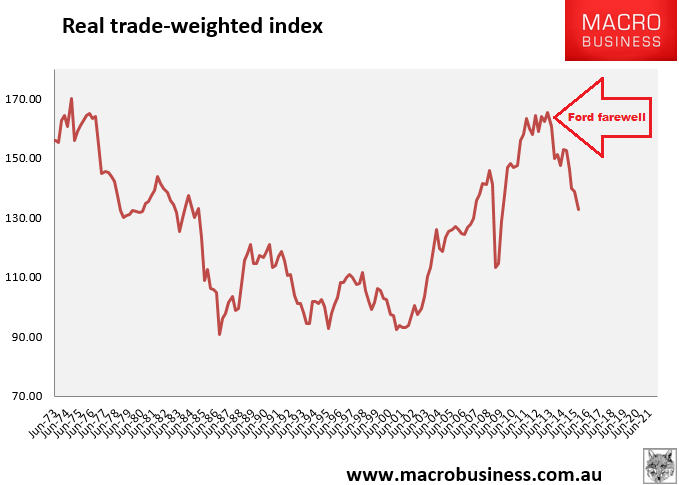Ironically, over the weekend Dumbfax had a good piece on how the car industry was murdered:
Holden says the industry provided direct employment for about 45,000 people and estimated another three to six people were employed in supporting industries for every one direct automotive job.
…Clearly, the impact of the coming loss of the local car industry will be deeply felt – but was it inevitable?
There has been much talk about the impact of the high Australian dollar, tariff barriers, free trade agreements, and the scale and fragmentation of Australia’s car market.
What this obscures is events in the crucial weeks of late 2013 when Australia’s auto manufacturing industry was on the line. Dig down deep and it comes to one question – was GM Holden genuinely encouraged to stay?
Holden was the key. Toyota wanted to stay. The company had a viable export market to the Middle East, a robust business plan and most importantly, pride on the line.
September 2013 and the Coalition is elected with a commanding majority and the new Abbott government it is in a hurry…On October 2 that business case is again given to the government, specifically new Industry Minister Ian MacFarlane in the boardroom at Holden in Adelaide.
One of those present at that meeting, South Australian Premier Jay Weatherill, says Holden wanted government assistance to continue.
…”It didn’t need to fall off the edge of a cliff in the way in which it will and then having to rebuild something from the ashes.”
Yes, the Abbottalypse is to blame but only for the end game.
For Australian manufacturing to prosper it requires three things: reasonable labour costs, competitive input costs and decent throughput. In Australia’s contemporary economic model of exporting dirt for income and leveraging that up to inflate house and land prices to feed consumption, neither of the first two preconditions is met. As Dutch disease inflates both wages and the currency, that, in turn, kills off the third pre-condition for manufacturing: volumes. Without exports the economies of scale just aren’t there in Australia’s small economy. These pressures had reached fever pitch in 2013 when Ford pulled the pin and triggered the cascading exits of the big three:

There is an irony, then, in Dumbfax looking to blame the Abbott Government for the death of the car industry. As its old media model dies, Dumbfax has fastened at the real estate teat for life – via Domain, as well as banking and associated advertisers – and is now little more than a sprawling property industry vertical. Editorial now mostly reflects these revenue streams and is dedicated not to the vitality of a diverse economic ecosystem but to the mass production of ‘Dumbfaxman’, the dim-witted, trivia-marinated specufestor that perpetuates its own business model. Via this sociological rent-seeking, Dumbfax is itself far more toxic to the long term prospects of large scale Australian manufacturing than any single government.
I had a drive of the new Commodore on the weekend and there is no doubt that it is a world class car with export potential. It has succeeded in global markets before and would do so again. Alas, it will no longer be built, even though it’s price competitiveness is now soaring for potential global markets and will continue to do so as the Australian dollar falls much further and Australian wage disinflation persists for another decade. It will be a terrible hidden pain for Dumbfaxman when the Commodore he could so comfortably have afforded a few years ago but didn’t want is replaced by an inferior GM product built in Korea that he wants but can’t afford.
Not that Dumbfaxman will know how this came to be!

